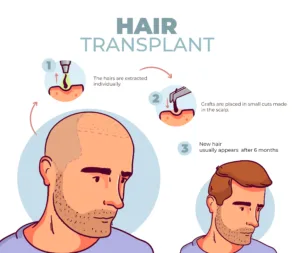WHAT IS A GRAFT - HAIR FOLLICLE GROUP
A graft is an English term and is an abbreviation for 'follicular units'. A graft consists of a collection of hairs that grow together and usually contain 1-4 hairs. A graft is thus a group of hair follicles.
In short, a graft is a graft of hair-bearing tissue that is transplanted to the scalp. These can be harvested from all over the body but the most common area is from the scalp. It is most often transplanted from the back of the head because of the long hairiness levels from that region. Its size and shape is determined by the choice of technique, tools and surgical approach. Read about how a hair transplant works.
HOW IS A GRAFT CREATED?
The ultimate way to remove a graft is to remove a very small amount of tissue from a hair follicle. Nowadays this is done using the FUE method in modern clinics. After a graft has been removed from the scalp, the graft dissects a follicular unit yielding on average 1-4 hairs. These are prepared for insertion into the recipient's scalp, all of which become individual hair grafts in a small prepared incision in the area to be transplanted. The graft is then inserted one by one at an appropriate depth and angle, the aim being to make it look as natural as possible.
MORE ABOUT THE TECHNIQUE OF REMOVING A GRAFT
A major advantage of a hair transplant is to try to minimise the impact on the scalp. The width of the tool varies but we use the smallest available on the market. Reducing the width when removing a graft makes it possible to place the hair follicles more densely.
on the scalp, thus providing the most natural result possible. The lesser need to make a larger donor area, allows a larger number of grafts to be transplanted very close to the scalp. This can be done without either damaging the scalp or compromising the blood supply. We want the hair to be as natural as possible and counteract the fact that the appearance of the scalp for Graften is not set tightly enough.
It is important to minimise the impact on the scalp. In the future, it may be necessary to add more hair, so it is important to take this into account. It is also important for the surgeon to plan for the future.
WHAT DETERMINES THE SURVIVAL OF THE GRAFT?
- What makes it crucial for so much of the grafts to survive beyond their area of origin is due to several factors. The follicular units have a complete anatomical and physiological structure and only careful stereo-microscopic dissection by skilled and experienced technicians can ensure their survival.
surgeons can ensure that they will get the best possible result in the long run and not suffer any damage during the different steps of the transplantation process. - Dehydration, in order to avoid the death of the graft, it is kept in a liquid solution (saline) before being transplanted, in a dry environment it can only survive for a short time.
- Temperature.
- Oxygen, when the follicular units are removed from the donor zone, they are deprived of oxygen so that the ATP process is interrupted. If the follicular units are without oxygen for too long, they will not survive.
- Proper selection, the importance of choosing hair from strong areas to make them as durable as possible.
- The skill of the surgeon.
- Tools.
There is confusion in the hair transplant world and it can be difficult for a patient to distinguish between the prices and what they get. 2500 grafts can contain between 25000-40000 hairs. During a consultation, we can discuss the extent and cost of the transplant for you. When we transplant, we transplant grafts, i.e. groups of hair follicles.
Graft counters
Follicular unit per square centimetre. Indicates the desired graft density. Below is an estimate only. Your needs will vary depending on hair characteristics and head size.

